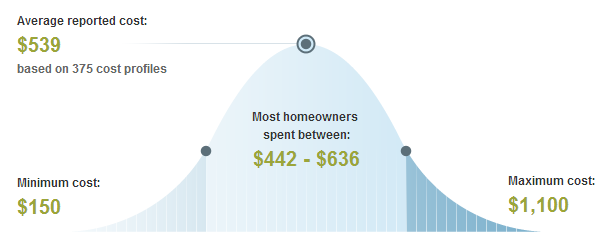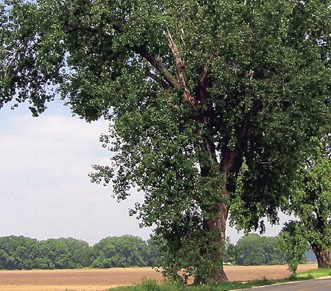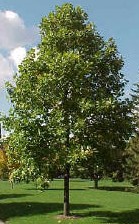Skip to a section:
- Costs – Find out what you’re going to pay for tree maintenance and removal in Kansas City, Kansas before you call the professionals. Don’t let it catch you unaware.
- FAQs – The sprawling urban landscape of Kansas City is home to a wide variety of trees and can support more kinds than the state tree. Find out what types thrive, what not to plant unless you want a challenge, healthy maintenance tips, city rules about residential tree maintenance, and more!
- Services – Time to call in the professionals. Our list provides you with any and everyone in the tree maintenance field located in Kansas City. Give the one closest to you a call.
How Much Do Tree Services Cost in Kansas City?
Kansas City, Kansas is not covered in corn fields. The city is plentiful with a wide of variety of trees that need care and maintenance on a regular basis to avoid damage to homes during inclement weather. Listed below is the cost information for tree maintenance and removal in the city.

How Much Does Tree Removal Cost?
Tree removal generally ranges from $442 to $636. Some trees produce more foliage than others, and more time is needed for pruning. There are also certain species that have difficult branch patterns and are harder to reach. Trees that are close to power lines are dangerous, and laborers often need to use specialized equipment. In addition, each branch must be carefully roped when removing. The amount of care and expertise required usually results in a higher price tag. The average cost homeowners will pay is $539.
How Much Does Stump Removal Cost?
Stump grinding costs vary due to the individual complexity of the job, but prices typically range from $80 to $150 per stump. Stump removal, on the other hand, will cost more because it involves completely uprooting the stump, which can be difficult because of the roots, location or type of wood the stump is made from. Kansas City residents can expect to pay between $200 to $300 for stump removal services.
Average Cost of Tree Maintenance in Kansas City
Tree trimming, cutting and pruning in Kansas City will cost between $141 and $193, depending on the types of trees and what they look like. When the arborist first comes out to assess the trees, he will look at how many branches and what kinds of trees are in the yard. If they are high maintenance, then the job will probably cost more, and the trees will need more regular appointments. If they’re low maintenance, then they’ll cost less and need the arborist out less often. The average price will be $167.
Kansas City Tree Facts & FAQ
Kansas City has two streets of trees dedicated to men and women of Kansas City who lost their lives during various wars. One is located on the sides of Liberty Memorial Drive, and the first planting was done in 1930. The second one is located on Ward Parkway and commemorates those who were killed during World War II. There is a gateway of 400 trees along with American flags and stone plaques. The city places great emphasis on their trees, as should its residents. Learn more about caring for trees in Kansas City as a resident below.
Kansas’ State Tree
 The state tree of Kansas is the cottonwood (Populus sect. Aigeiros), and it is prevalent in the state’s landscape. The cottonwood features a clear bole and an open spreading crown. It blooms colorful flowers and has a simple veined leaf. The state of Kansas has dubbed the cottonwood as the “pioneer tree of the prairie.” Cottonwoods grow quickly and can often reach 80 feet. The largest one known in Kansas is located near Studley and is 97 feet tall with a trunk circumference of 35 feet and a spread of 157 feet.
The state tree of Kansas is the cottonwood (Populus sect. Aigeiros), and it is prevalent in the state’s landscape. The cottonwood features a clear bole and an open spreading crown. It blooms colorful flowers and has a simple veined leaf. The state of Kansas has dubbed the cottonwood as the “pioneer tree of the prairie.” Cottonwoods grow quickly and can often reach 80 feet. The largest one known in Kansas is located near Studley and is 97 feet tall with a trunk circumference of 35 feet and a spread of 157 feet.
Fruit Trees that Thrive in Kansas City
Kansas City is favorable for a wide variety of fruit trees. By removing overwintering plant debris and fruit drops each year, you can lower the chances of infection by pests. Residents can plant standard, dwarf or semi-dwarf fruits that are hardy for growth in Kansas City. The Fuji apple tree (Malus domestica) and peaches are popular in the area. In no time, you’ll be harvesting some delicious apple and peach pies. The area is also conducive for plum, cherry and pear trees.
Choosing the Right Trees to Plant
 There are also common trees that grow several feet each year in Kansas City and thrive well in the Kansas City climate and soil. The hybrid poplar (Populus deltoids) grows 5 to 8 feet a year. It’s often planted in rows as a shade tree to reduce energy expenses. The weeping willow (Salix Babylonica) can grow from 3 to 8 feet a year and is popular in Kansas City. The quaking aspen (Populus tremuloides) is a member of the same family as the hybrid polar and is also a speedy growing tree. It adds instant beauty to any landscape with its brilliant fall foliage. The green giant (Arborvitae) is a hybrid and provides an exceptional landscape tree for use as a hedge, screen or windbreak.
There are also common trees that grow several feet each year in Kansas City and thrive well in the Kansas City climate and soil. The hybrid poplar (Populus deltoids) grows 5 to 8 feet a year. It’s often planted in rows as a shade tree to reduce energy expenses. The weeping willow (Salix Babylonica) can grow from 3 to 8 feet a year and is popular in Kansas City. The quaking aspen (Populus tremuloides) is a member of the same family as the hybrid polar and is also a speedy growing tree. It adds instant beauty to any landscape with its brilliant fall foliage. The green giant (Arborvitae) is a hybrid and provides an exceptional landscape tree for use as a hedge, screen or windbreak.
While Kansas City is favorable for a wide species of trees, there are some that you should avoid. The Norway maple (Acer platanoides) has a shallow root system that can damage driveways and foundations. In addition, this species of maple is often under attack by fungi. Although the ash tree (Fraxinus) was planted in large numbers in the past, it has recently come under attack by a new pest and is quickly being destroyed.
Tree Regulations Required by the City
All owners and occupants of any structure are required to keep trees trimmed so that the branches are no lower than 7.5 feet from the street or sidewalk. Branches may not touch power lines. KCP&L, Kansas’ utility company, recommends that small trees and shrubs are planted at least 20 feet from power lines, medium trees 35 feet away, and large trees 45 feet away. KCP&L also requires that anyone who gets within 10 feet of power lines in the city has a qualified license to work on the power lines, so make sure that your tree service professional is licensed to do so if he’s working on trees near power lines. Residents also have the option to put in a request with the utility company to have vegetation trimmed near the power lines, and the company performs maintenance near the lines regularly.
Keeping Your Trees Healthy
Even if you plant a tree that is favorable to the Kansas City climate and soil, proper tree care is important for the health of the tree as well. Often, root problems lead to other issues. If a tree is leaning more to one side than the other, it is often an indication that root damage has gone too far. You can always contact a licensed arborist or tree service company to evaluate and help repair the tree. Proper tree care entails placing the tree in its most favorable location, applying needed moisture, regular pruning, trimming, and using the appropriate fertilizers and nutrients. With the proper tree healthcare, you can avoid potential root system problems, and the tree will thrive during its lifespan.
Plant Hardiness Zones in Kansas
Here are the plant hardiness zones for Kansas as provided by the USDA:

Image Sources:
Cottonwood tree
Hybrid poplar
Local Tree Services in Kansas City
Featured Tree Services in Kansas City
Affordable Tree Service
Phone:844-287-3363
Service Areas: Kansas City Metro Area
Services Offered: Tree Trimming, Tree Removal, & Stump Grinding
Website: http://www.affordabletreeservice.biz
Promotions: Winter rates – 25% off
Ward Tree Care
Phone:(816)325-0374
Service Areas: 30 mile radius of 64118
Services Offered: Tree Trimming Tree Removal Stump Grinding Cavity Filling Lateral Reduction Shaping Pruning Cabling Dormant oil Spray Insecticide Spray Fungicide Spray
Website: http://www.wardtreecarekc.com
Promotions: Groupon and Valumail
